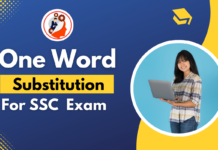Table of Contents
Active and Passive Voice Rules
Active and Passive Voice Rules: As you are already aware, there are many rules that are followed in the English Language, especially grammar. Right from the sentence structure, tenses, voice, usage of prepositions, nouns, etc., there are many rules that have to be followed. These rules are quite simple, even though at first they may appear complicated. When you follow these rules properly, you can master English Grammar tricks with ease.
In IBPS exams and many competitive exams, you will come across many questions about English Grammar. Among these, there are questions related to active and passive voice. Let us look at this topic in detail.
Also, Check the Study Material
An action of a subject, in relation to an object, is expressed in two ways. These two ways of expressing the action of a subject are known as Voices.
1. Active Voice
2. Passive Voice
Examples of Active and Passive Voice
- I write a letter. (Active Voice)
- A letter is written by me. (Passive Voice)
The structure of the same sentence changes when expressed as Active Voice or Passive Voice. The meaning of a sentence either expressed as Active Voice or Passive Voice, remains the same.
Active and Passive Voice Question PDF
Active and Passive Voice Rules
Active and Passive Voice are two different ways of expressing the same idea in a sentence. In active voice, the subject of the sentence performs the action, while in passive voice, the subject receives the action.
Here’s an example to illustrate the difference between active and passive voice:
Active Voice: The cat chased the mouse.
Passive Voice: The mouse was chased by the cat.
In the active voice sentence, “the cat” is the subject of the sentence, and it is performing the action of “chasing the mouse.” In the passive voice sentence, “the mouse” is the subject of the sentence, and it is receiving the action of “being chased by the cat.”
Active and Passive Voice Rules for Present Simple Tense
Here in this table, we are elaborating Rules of Active and Passive Voice with examples for Present Simple.
| Active Voice | Passive Voice (Auxiliary Verb – is/am/are) |
| Subject + V1+s/es+ object | Object+ is/am/are+ V3+ by + subject |
| Subject + Do/does+ not + V1 + Object | Object + is/am/are+ not + V3+ by Subject |
| Does+ Subject+ V1+Object+? | Is/am/are + Object+ V3+ by subject +? |
Active and Passive Voice Example with Answers of Present Simple Tense
Active: He reads a novel.
Passive: A novel is read.
Active: He does not cook food.
Passive: Food is not cooked by him.
Active: Does he purchase books?
Passive: Are books purchased by him?
Active: They grow plants.
Passive: Plants are grown by them.
Active: She teaches me.
Passive: I am taught by her.
Active and Passive Voice Rules for Present Continuous Tense
Below we will explain the Rules of Active and Passive Voice with examples for Present Continuous tense.
| Active Voice | Passive Voice (Auxiliary Verb- is/am/are + being) |
| Subject + is/am/are+ v1+ ing + object | Object+ is/am/are+ being+ V3+ by + subject |
| Subject + is/am/are+ not+ v1+ ing+ object | Object + is/am/are+ not + being+V3+ by Subject |
| Is/am/are+ subject+v1+ing + object+? | Is/am/are + Object+ V3+ by subject +? |
Active and Passive Voice Exercises of Present Continuous Tense
Active: Esha is singing a song.
Passive: A song is being sung by Esha.
Active: Kritika is not chopping vegetables.
Passive: Vegetables are not being chopped by Kritika.
Active: Is Ritika buying a table?
Passive: Is a table being bought by Ritika?
Active: They are serving poor people.
Passive: Poor people are being served by them.
Active: She is disturbing Dinesh.
Passive: Dinesh is being disturbed by her.
Active and Passive Voice Rules for Present Perfect Tense
You can understand passive voice for present perfect tense from the list which are given below.
| Active Voice | Passive Voice (Auxiliary Verb- has/have +been) |
| Subject + has/have+ v3+ object | Object+ has/have+ been+ V3+ by + subject |
| Subject + has/have+ not+ v3+ object | Object + has/have+ not + been+V3+ by Subject |
| Has/have+ subject+ v3 + object+? | Has/Have + Object+ been+V3+ by subject +? |
Active and Passive Voice Example with Answers of Present Perfect Tense
Active: Nitesh has challenged her.
Passive: She has been challenged by Nitesh.
Active: Radhika has not written an article.
Passive: An article has not been written by Radhika.
Active: Have they left the apartment?
Passive: Has apartment been left by them?
Active: She has created this masterpiece.
Passive: This masterpiece has been created by her.
Active: I have read the newspaper.
Passive: The newspaper has been read by me.
Active and Passive Voice Rules for Past Simple Tense
Here in the below table, you can check Active and Passive Voice Rules for past simple tense.
| Active Voice | Passive Voice (Auxiliary Verb- was/were) |
| Subject + V2+ object | Object+ was/were V3+ by + subject |
| Subject +did+ not+v1+ object | Object + was/were+ not +V3+ by Subject |
| Did+ subject+V1+ object+? | Was/were + Object+ V3+ by subject +? |
Active and Passive Voice Exercises of Past Simple Tense
Active: Reema cleaned the floor.
Passive: The floor was cleaned by Reema.
Active: Aisha bought a bicycle.
Passive: A bicycle was bought by Aisha.
Active: Naman called my friends.
Passive: My friends were called by Naman.
Active: I saved him.
Passive: He was saved by me.
Active: Miraya paid the bills.
Passive: The bills were paid by Miraya.
Active and Passive Voice Rules for Past Continuous Tense
We can easily convert sentences from Active to Passive Voice according to given rules below.
| Active Voice | Passive Voice (Auxiliary Verb- was/were + being) |
| Subject + was/were + v1+ing+ object. | Object+ was/were +being+V3+ by + subject |
| Subject +was/were+ not+v1+ing + object | Object + was/were+ not +being+V3+ by Subject |
| Was/were+ Subject + V1+ing + object+? | Was/were + Object+ being+v3+ by+ subject+? |
Active and Passive Voice Examples with Answers of Past Continuous Tense
Active: Nitika was painting the wall.
Passive: The wall was being painted by Nitika.
Active: Manish was repairing the car.
Passive: The car was being repaired by Manish.
Active: Were you reciting the poem?
Passive: Was the poem being recited?
Active: She was baking the cake.
Passive: The cake was being baked by her.
Active: She was watching me.
Passive: I was being watched by her.
Active and Passive Voice Rules for Past Perfect Tense
There are certain Active and Passive Voice Rules for Past perfect tense, with these only you can convert any sentence in Passive Voice.
| Active Voice | Passive Voice (Auxiliary Verb- had +been) |
| Subject + had + v3+ object. | Object+ had+been +V3+ by + subject |
| Subject +had+ not+v3+ object | Object + had+ not +been+V3+ by Subject |
| Had+ Subject + V3+ object+? | Had + Object+ been+v3+ by+ subject+? |
Active and Passive Voice Exercises of Past Perfect Tense
Active: Misha had cleaned the floor.
Passive: The floor had been cleaned by Misha.
Active: Vidhi had not received the parcel.
Passive: The parcel had not been received by Vidhi.
Active: Vishal had solved the doubt.
Passive: The doubt had been solved.
Active: Had they caught the thief?
Passive: Had the thief been caught by them?
Active: I had paid fifty thousand.
Passive: Fifty thousand had been paid by me.
Active and Passive Voice Rules for Future Simple Tense
You can check Active Voice and Passive Voice Rules chart for future simple tense.
| Active Voice | Passive Voice (Auxiliary Verb- will+ be) |
| Subject + will+ v1+ object. | Object+ will+ be +V3+ by + subject |
| Subject +will + not+ V1+object | Object + will+ not +be+V3+ by Subject |
| Will+ Subject + V1+ object+? | Will + Object+ be +v3+ by+ subject+? |
We can better understand Rules of Active and Passive Voice with examples for future simple tense.
Active and Passive Voice Examples with Answers of Future Simple Tense
Active: Kriya will sew the bag.
Passive: The bag will be sewed by Kriya.
Active: Disha will not arrange the things.
Passive: The things will not be arranged by Disha.
Active: Will you mop the floor?
Passive: Will the floor be mopped by you?
Active: They will post the letter.
Passive: The letter will be posted.
Active: Reena will save money.
Passive: Money will be saved by Reena.
Active and Passive Voice Rules for Future Perfect Tense
Here, we are sharing the Active Voice and Passive Voice Rules chart for future perfect tense.
| Active Voice | Passive Voice |
| Subject + will+ have +v3+ object. | Object+ will+ have+ been +V3+ by + subject |
| Subject + will+ have +not+v3+ object. | Object + will+ have +not+been+v3+ subject |
| Will+ Subject+have+v3+ object+? | Will + object+have+been+v3+by +subject+? |
Active and Passive Voice Exercises of Future Perfect Tense
Active: They will have brought the toy.
Passive: The toy will have been brought by them.
Active: Nimesh will not have changed the table cover.
Passive: The table cover will not have been changed by Nimesh.
Active: Will she have written the notes.
Passive: Will the notes have been written by her?
Active: They will have won the match.
Passive: The match will have been won by them.
Active: Vijay will have washed a shirt.
Passive: A shirt will have been washed by Vijay.
There is no Passive Voice formation for these tenses-
1.) Present Perfect Continuous Tense
2.) Past Perfect Continuous Tense
3.) Future Perfect Continuous Tense
4.) Future Continuous Tense
FAQ on Active and Passive Voice
Q. What are active and passive voice questions?
Ans: Example:
Active voice: She prepares dinner.
Passive voice: The dinner is prepared by her.
Active voice: She knows him.
Passive voice: He is known to her.
Active voice: Juice fills the jar.
Passive voice: The jar is filled with juice.
Q. How do you identify active and passive voice?
Ans: When the actor (and the actor can be a person or object) comes before the action in a sentence, you have active voice. When the actor comes after the action or when the actor is completely absent from the sentence, you have passive voice.
Q. Which tenses have no passive voice?
Ans: The sentences of the following four tenses cannot be changed into passive voice.
Present Perfect Continuous Tense.
Past Perfect Continuous Tense.
Future Perfect Continuous Tense.
Future Continuous Tense.














..